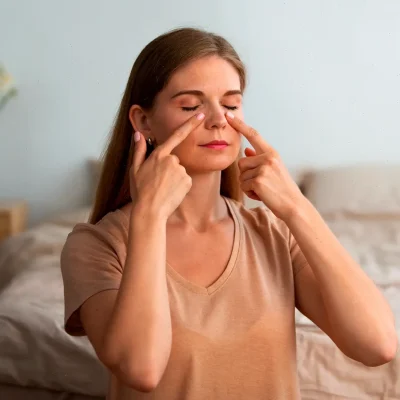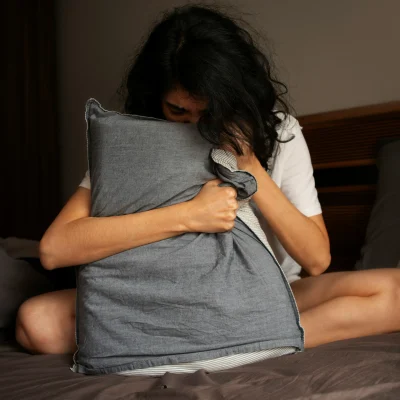Introduction
Anxiety is a frequent visitor in our lives. It arrives uninvited, making us replay past mistakes or imagine catastrophic scenarios of the future. In such moments, we lose connection with the present — and with it, the ability to influence our lives.
Gestalt therapy offers simple yet powerful tools to return to the “here and now.” This article includes not only theory but also real examples and exercises that can help you reduce anxiety starting today.
How Anxiety Steals the Present
Example 1: Katya is preparing for a work presentation. Instead of focusing on her preparation, she thinks, “What if I forget my speech? What if my colleagues think my report is weak?” Her hands sweat, her heart races, and her mind is filled only with catastrophic scenarios.
What’s happening? Katya is not in the present — she is in an imagined future where everything goes wrong. Her anxiety is fueled not by facts, but by fantasies.
Example 2: After an argument with a friend, Maxim spends the whole evening replaying their conversation: “I should have said it differently… Why did I respond so harshly?” He gets angry at himself, can’t fall asleep, and wakes up feeling exhausted.
What’s happening? Maxim is stuck in the past. Instead of experiencing his emotions and moving on, he endlessly “chews over” the situation, intensifying his anxiety.
Gestalt Therapy: How It Works
Gestalt therapy teaches awareness of what is happening here and now, rather than in imagined scenarios. Its key ideas are:
- “I am what I feel in this moment” — if you are angry, sad, or anxious, it’s important to acknowledge these feelings, not suppress them.
- Unfinished situations = anxiety — unspoken words, unresolved conflicts, and postponed decisions create tension.
- Responsibility instead of blame — instead of “He made me angry,” ask yourself, “How am I supporting this anger myself?”
Gestalt Therapy Practices: 4 Exercises with Examples
- Exercise: “What am I feeling right now?”
How to apply:
Pause and ask yourself:
- Body: Where is the tension? Trembling? Warmth or cold?
- Emotions: What do I feel — fear, anger, sadness?
- Thoughts: What am I thinking right now?
Example: Alina feels nervous before a date. Instead of succumbing to panic (“What if I have nothing to say?”), she pauses and notices:
- Body: trembling hands, rapid breathing.
- Emotions: fear of rejection.
- Thoughts: “I’m not interesting enough.”
Effect: Simply noticing these reduces the intensity of anxiety. Alina takes several deep breaths and realizes her fear is not a fact, just a thought.
- Technique: “Grounding 5-4-3-2-1”
How to apply: When anxiety strikes, shift attention to reality:
- 5 things you can see.
- 4 things you can touch.
- 3 sounds you hear.
- 2 smells you notice.
- 1 taste in your mouth.
Example: Sergey begins to panic during an important meeting. He feels his pulse quicken. Instead of sinking into anxiety, he:
- Sees a clock, pen, laptop, window, coffee cup.
- Touches the table, notebook, his shirt, a ring on his finger.
- Hears a colleague’s voice, the hum of the air conditioner, the creak of a chair.
- Smells coffee and perfume.
- Tastes mint gum.
Effect: Within 30 seconds, he returns to reality, and anxiety recedes.
- Method: “Empty Chair” (for unfinished situations)
How to apply: If you are troubled by something unspoken (resentment, anger, guilt):
- Place an empty chair opposite you.
- Imagine the person you have unresolved issues with is sitting there.
- Say everything you feel to that person.
Example: Oleg is angry at a former friend who betrayed him. He sits opposite the empty chair and says:
- “I’m angry that you didn’t support me back then.”
- “I’m hurt that we no longer communicate.”
- “I want to let go of this situation.”
Effect: After this exercise, Oleg feels relief — his emotions have found an outlet instead of being bottled up inside.
- “Focus on Breathing”
How to apply:
- Inhale for 4 counts → hold for 2 → exhale for 6.
- Repeat 5–7 times, thinking only about your breath.
Example: Masha starts to panic before an exam. She remembers the technique:
- Takes a slow breath (1…2…3…4).
- Holds her breath (1…2).
- Exhales (1…2…3…4…5…6).
Effect: Within a minute, her pulse normalizes, and her thoughts clear.
How to Incorporate Mindfulness into Daily Life
- Mini-checks: Ask yourself 3 times a day, “Where are my thoughts right now? In the past, future, or present?”
- One thing at a time: If you’re eating — just eat, don’t scroll social media. If you’re walking — notice your steps, sounds, and smells.
- Anxiety journal: Write down, “I am anxious about… Is this a real threat or a fantasy?”
Conclusion
Anxiety lives where there is no present — in past regrets and future fears. Gestalt therapy doesn’t promise that anxiety will disappear forever, but it teaches us to return to the “here and now,” where we can breathe, feel, and act.
Try today:
- In moments of anxiety, ask yourself: “What do I really feel right now?”
- Use the 5-4-3-2-1 technique to ground yourself.
As Gestalt therapy founder Fritz Perls said, “Anxiety is the gap between now and then.” The more often you return to the present, the less power anxiety has over you.







